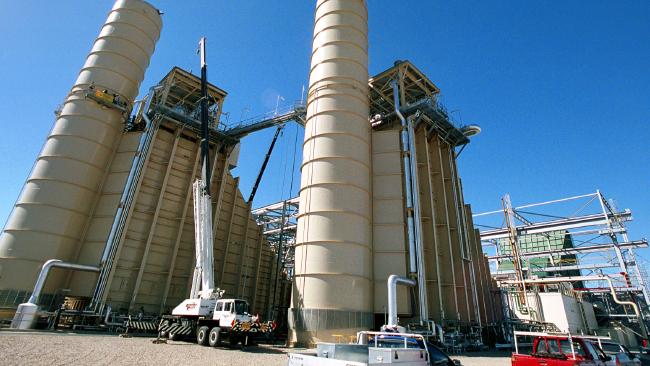The South Australia government has made a dramatic change to its major energy tender, opening what was supposed to be a competition among “low carbon” energy sources to high emitting peaking gas plants.
Documents released this week show that despite claiming its preference for renewable energy, the government’s tender for 389GWh of power each year – broadly equivalent, it says, to a power plant of at least 100MW – will have an emissions limit of 700kg of Co2 equivalent.

This is more than the 400kg/MWh when it sought expressions of interest nearly a year ago (which itself was an increase from the near zero emissions it had originally sought) and appears design to allow peaking gas plants to contest the tender. It would also cause the state’s emissions profile to increase rather than fall.
The South Australian government has been canvassing options for new dispatchable generation – including solar towers with storage, and new gas plants – for more than a year now, and wants to have the new competitor in place by the start of 2018.
“The State’s strong preference is that 100 per cent of the generation should be provided by renewable energy sources,” the tender document says, citing solar towers with storage, solar PV with storage, biomass and pumped hydro as possible new technologies.
But it also says it is open to suggestions for the “re-introduction of capacity from unused plant within South Australia”, which could include the likes of the 17-year-old Pelican Point gas plant, which mothballed the last of its capacity just days before the closure of the Northern brown coal generator in May.
South Australia’s problem is that the majority of those gas plants are controlled by only two companies – AGL and Origin – and they set the prices that causes the state’s wholesale electricity prices to jump so high. This was the case a decade ago before the arrival of wind and solar, but was weakened as more renewables were put into the grid.
However, their pricing power has now been restored since the closure of the last coal fired generator, and they have shown they are willing to exploit that power ruthlessly, as they did when the connection to Victoria was closed for repairs in July, and on occasions since.
To unlock that pricing grip, South Australia wants, at the very least, a new competitor – even if it is a facility like Engie’s Pelican Point, which was built 17 years ago and which was mothballed just 10 days before the closure of the Northern brown coal power station.
It is not clear that commissioning a new gas-fired generator or re-commissioning an old one will do much to reduce competition, seeing that it would leave the state’s electricity prices still being set by a small group of gas fired generator owners.

Most observers suggest that new technology – be it the solar tower and storage project proposed by US company SolarReserve, or large scale solar PV with storage of the like propose by Lyon Solar, or possibly DP Energy or the former head of the Hazelwood brown coal power plant – would loosen the grip.
While the tender documents say that the government would prefer a renewable energy source, the rules it has announced largely favour gas.
Not only have the emissions limits been dramatically weakened, the contract time is set at 10 years (likely too short for a new first of its kind project like solar storage) and the government wants the new contact to be in place within 6 months of a decision (likely impossible for any new project). It also wants the generator to be linked with a retailer, which may complicate matters for many of the solar companies.
The state is also offering $24 million to help find local gas reserves to serve the local market, and on Tuesday released a new report saying that huge reserves of unconventional gas (shale gas and deep coal) should be exploited in the Cooper Basin.
It could be there will be some flexibility with those rules, but the key may be in the flexibility of contract prices. Solar storage, be it in solar towers or solar PV with battery storage, would be able to offer a fixed price for 20 years.
The main challenge for solar towers and storage is that because it is a first of a kind project for the country, with both equity and debt carrying added risk, it would need support from the likes of ARENA of the CEFC to compete, particularly if it has to compete with gas fired generators that were built 17 years ago.
However, a gas-fired generator, and particularly a new one, would be unlikely to want to carry the risk of higher gas prices in locking in a contract for 10 years or more. The rules express a preference for fixed prices, but allows some flexibility.
It would be extraordinary, however, if the state government chose to carry the risk of fuel prices. It would appear to defy the point of the tender. Maybe the state should write a short term contract with a facility like Pelican Point while it lays the groundwork for the solar storage technology of its choice.
As we have reported last year Gas or solar towers: Will South Australia blink in push to clean energy and more recently here (Gas vs solar: Why South Australia needs to seize the future), the next step the state makes will be a crucial one.
Within the next year, its share of variable wind and solar generation will likely exceed its 2025 target of 50 per cent. That means that it needs to think seriously about storage and dispatchable power options, but despite pressure from the fossil fuel industry, the solution for its power needs and economic development does not lie with old technologies.
The tender is seen as one of the last major opportunities to develop the first solar thermal and storage plant in Australia, a technology that is now being built in the US, Chile, Morocco and South Africa, and is also a major focus in China and the Middle East.
SolarReserve, which has opened a 110MW plant in Nevada and is now building a similar plant in South Africa, is seen as the favourite among the solar tower technologies, ahead of Australia’s Vast Solar and the untested and undeveloped Solastor graphite technology being promoted by John Hewson.
Around 25 per cent of the government’s power needs will go to new technologies – renewable and battery storage – but this will be brought in at a smaller scale for around 100GWh or more.
The community in Port Augusta, the location of the last coal fired power station, is in no doubts what it wants to see built.
Lisa Lumsden, spokesperson for Repower Port Augusta said, the South Australian Government “has a clear choice in this tender, use their purchasing power to create a new clean industry and new jobs with 24 hour solar thermal or prop up an old polluting industry with gas.
“It’s disappointing that the State Government has decided to let more polluting gas generation onto the field by raising the pollution limit by almost double since November last year.
“We want to see Jay Weatherill to invest in our future by using this tender to create new jobs and new industry for Port Augusta by backing on-demand solar thermal power.
“It’s critical the State Government takes this opportunity to finally make solar thermal happen, not lock in a risky long-term contract with a polluting gas company tied to the fluctuating and expensive gas market.
“Building solar thermal in Port Augusta would create manufacturing opportunities, provide the network benefits of fossil fuels without the pollution as well as new long-term jobs and solar power on demand. Solar thermal is the right choice for our state, not old polluting gas.”









